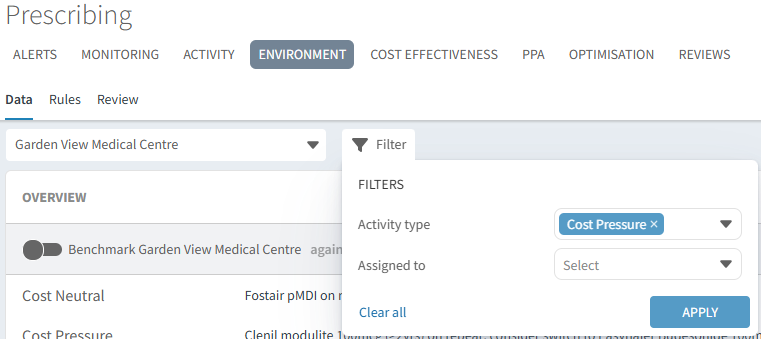TABLE OF CONTENTS
Introduction
Inhalers are a lifeline for millions of people with asthma and COPD—but they also come with an environmental cost. Some types, particularly metered dose inhalers (MDIs), use powerful greenhouse gases as propellants, contributing significantly to the NHS’s carbon footprint. As the NHS works toward its net zero goals, general practice has a key role to play in supporting greener prescribing. By choosing lower-carbon inhaler options where appropriate, clinicians can help protect both patient health and the planet.
Accessing the Prescribing Dashboard
Click on the Services icon and select Prescribing.

Click on the Environment tab.

Navigating the Prescribing Dashboard
The reports are split into four categories:
- Cost Neutral
- Cost Pressure
- Cost Saving
- Switch Drug
To view just one of these four categories at any one time, you can filter the dashboard using the filter icon. Select your activity type as one of the categories and click Apply.

See how many patients are in each report using the Patient count column.

To identify the patients, click on View.

Click on the Patients tab.

You can copy the patient's NHS number to review their record or export the full list of patients for further action. To learn more about managing the patient list, please refer to this support article.
Your data can be viewed through Code Breakdown, which helps prioritise tasks by focusing on inhalers by group and dose. To access the code breakdown, click on the Benchmark tab, then toggle View Codes.

The code breakdown is colour coded to provide a visual representation on the breakdown features and tools. This helps to visualise the volume of each inhaler in relation to the report.


To view the breakdown or patient list for a specific inhaler, click on the medication name or colour. This action will update all data on the page, including demographics and the patient list.

Next Steps
Use the insights above to transition patients to the recommended alternatives. Additionally, these insights can be utilised to drive broader practice-wide actions. Below are some further considerations:
- Raise Patient Awareness - Use SMS, letters, or posters to inform patients about the environmental impact of inhalers. Direct them to resources such as Greener Practice leaflets or videos that explain the benefits of switching to lower-carbon options.
- Consider Inhaler Reviews with a Sustainability Focus - Incorporate environmental considerations into annual asthma/COPD reviews. Discuss switching from pressurised metered-dose inhalers (pMDIs) to dry powder inhalers (DPIs) or soft mist inhalers where clinically appropriate.
- Avoid Blanket Switching if Possible - Ensure all changes are patient-centered and clinically justified. Use shared decision-making to explore suitable alternatives.
- Improve Inhaler Technique - Provide training to ensure patients use their inhalers correctly, reducing waste and improving outcomes. Consider group education sessions or video tutorials to safeguard appointments.
- Promote Proper Disposal - Encourage patients to return used inhalers to pharmacies for safe disposal or incineration, reducing environmental harm.
- Engage the Whole Practice Team - Involve clinicians, pharmacists, and administrative staff in sustainability initiatives. Consider appointing a “green champion” to lead environmental health projects.
If you require any further assistance on the process above, please contact the Ardens Manager Support Team on: support-manager@ardens.org.uk
